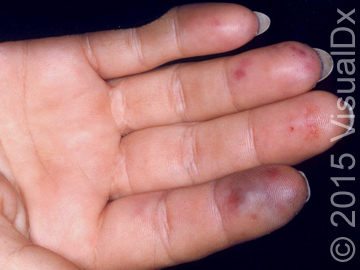|
|
| Cardiac Presentations of COVID-19 from the Frontlines |
Sr. Editor of Practical Cardiology Gretchen Cuda Kroen interviews Dr. Nir Uriel, a cardiologist on the frontlines of the COVID-19 epidemic in NYC. Dr. Uriel describes the cardiovascular presentations of COVID-19 he and his colleagues are seeing, how they diverge from the conventional respiratory presentation, and what this means for the diagnosis and treatment strategies for these patients.
|
| |
|
| Increased Stroke Risk and Neurological Injury in COVID-19 Patients |
|
Mitchell Elkind, M.D. , neurologist and epidemiologist at Columbia University discusses the neurological changes seen in COVID-19 patients, including an increased risk of stroke and seizure.
|
| |
|
| The Cardiac Dangers of Hydroxychloroquine and Azithromycin |
|
Dr. Mariell Jessup, Chief Science and Medical Officer at the AHA discusses the cardiac dangers of combining hydroxychloroquine and azithromycin to treat coronavirus patients with underlying heart disease, the controversy surrounding putting medical students and trainees on the frontlines of COVID-19 too soon, and the changing roles of telemedicine.
|
| |
|
|
|
| |
| Stress Induced Heart Attacks Linked to PTSD |
 New research from Emory University is shedding light on a potential link between post-traumatic stress disorder (PTSD) and mental stress-induced myocardial ischemia in patients with stable coronary artery disease. New research from Emory University is shedding light on a potential link between post-traumatic stress disorder (PTSD) and mental stress-induced myocardial ischemia in patients with stable coronary artery disease.
|
| |
|
| Spike in Heart Attack Risk Linked to Wildfires |
 Investigators from the California’s Department of Public Health have uncovered a startling link between wildfires and a sharp rise in out-of-hospital cardiac arrests. Heavy wildfire smoke increased risk of out-of-hospital cardiac arrests by as much as 70%, researchers report. Investigators from the California’s Department of Public Health have uncovered a startling link between wildfires and a sharp rise in out-of-hospital cardiac arrests. Heavy wildfire smoke increased risk of out-of-hospital cardiac arrests by as much as 70%, researchers report.
|
| |
|
|
And Just In Case You Missed It…..
|
|
| |
| Staying Healthy Amid COVID19: What Patients with Cardiovascular Disease Need to Know |
 Gretchen Cuda Kroen, Senior Editor of Practical Cardiology interviews Stephen Kopecky, M.D., a cardiologist and specialist in Preventative Medicine from the Mayo Clinic about what patients and their physicians need to know about staying healthy with heart disease in the wake of COVID19. Gretchen Cuda Kroen, Senior Editor of Practical Cardiology interviews Stephen Kopecky, M.D., a cardiologist and specialist in Preventative Medicine from the Mayo Clinic about what patients and their physicians need to know about staying healthy with heart disease in the wake of COVID19.
|
| |
|
| Why Older Patients Are More At Risk for COVID-19 : A Decline In ACE2 Expression |
 A new perspective from a team of Maryland-based cardiovascular clinicians sheds insight on an often forgotten facet of the inherent COVID-19 risk carried by patients with cardiovascular history: the decline in angiotensin-converting enzyme 2 (ACE2) expression associated with aging, and the response of care most common in such patients. A new perspective from a team of Maryland-based cardiovascular clinicians sheds insight on an often forgotten facet of the inherent COVID-19 risk carried by patients with cardiovascular history: the decline in angiotensin-converting enzyme 2 (ACE2) expression associated with aging, and the response of care most common in such patients.
|
| |
|
| Image IQ: Petechia and Palpable Purpura on the Palms of Hands, Fingers, and Toes |
 A 40-year-old woman went to the doctor after petechia and palpable purpura appeared on the palms of her hands, fingers, and toes. She appeared chronically ill and had significant weight loss. Her doctor also noted the presences of Osler nodes. She did not have any recent injuries or skin punctures and reported she had been in good health until the last few weeks. Based on these clues, how would you diagnose this patient? A 40-year-old woman went to the doctor after petechia and palpable purpura appeared on the palms of her hands, fingers, and toes. She appeared chronically ill and had significant weight loss. Her doctor also noted the presences of Osler nodes. She did not have any recent injuries or skin punctures and reported she had been in good health until the last few weeks. Based on these clues, how would you diagnose this patient?
|
| |
|
| We want to hear from you! |
|
Did you love an article you read in Practical Cardiology? Disagree with an author’s conclusions? Want to share how you solved an issue in your practice? Then Practical Cardiology editors want to hear from you! Please send your comments to GCudaKroen@mjhlifesciences.com.
|
| |
|